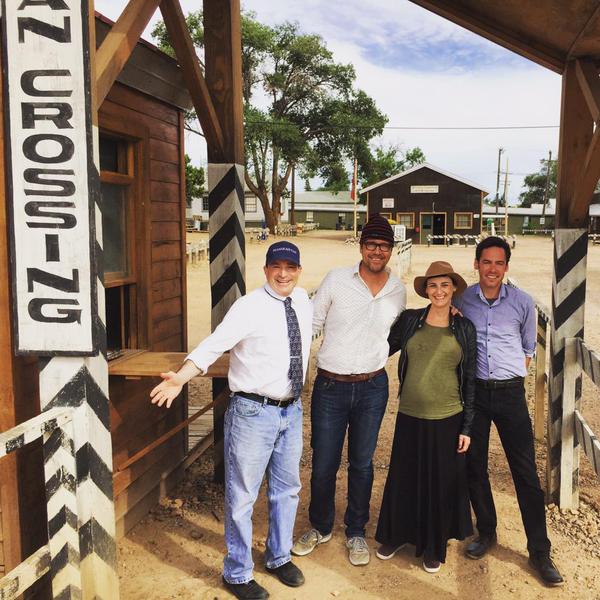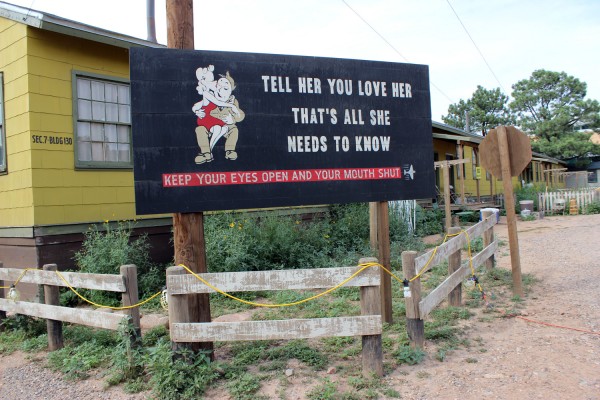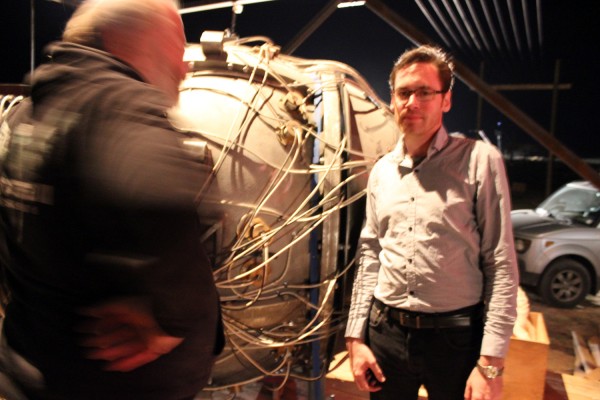Season two of the WGN America show Manhattan premieres tonight. I figured this would be a good excuse to plug it, and to talk about the historical consulting I’ve been doing for it.
The best way I have come up with to describe Manhattan is that it is an alternate-reality version of the Manhattan Project that is heavy on the film noir. Almost all of the characters are entirely fictional, not named after actual World War II figures (there are a couple exceptions to this, that I will come to), and the stories are fictional. However they are set in the same physical universe as ours, and the historical context is based (with some diversions) on the actual one. For Manhattan, the Manhattan Project was not just a specific set of historical events that led to the atomic bomb, but an unfolding historical context that ultimately rendered deep and lasting changes to the United States. It is not so much the story of the creation of a new weapon as it is the creation of a new world.
I was approached about consulting by the head writer, Sam Shaw, last year. I had seen some of Season 1, which took the Los Alamos story up until around the summer of 1944, when the lab had to be radically reorganized to focus on implosion. What I had liked about the first season is that they took something that most people would regard as pretty obscure — the intense effort that had been made for the (eventually abandoned) Thin Man bomb design — and made it into the key pivot around which the drama turned. To me that showed a pretty nuanced historical sensibility, focusing on the “loser” of history (Thin Man) as opposed to the “winner” (implosion).

Posting at the gate of the Los Alamos set — David Salzberg (science consultant), Sam Shaw (head writer), Lila Byock (writer), and myself.
The consulting job was for me an unusual one. I have consulted for documentaries in the past, and that is a relatively straightforward gig: they want to know what happened, I want to tell them what happened. Consulting for a fictional show was something else. They did want to know what happened, but less because they were going to replicate it (in many cases, they were not), but because they wanted the “flavor” of it to inform their fictional plots. I can’t go into too many details about what we talked about (not because I am bound to not talk about the show, but because I have been asked not to say anything that might spoil any of this season’s surprises, and I’m not even sure what all of those surprises are), but I found it an immensely fun challenge, trying to give them “options” that would be true to the “color” of the times.
Many of the questions were along the lines of, “we need to do this sort of thing with the story, what were the situations that actually happened that might provide a model for how we could make this happen?” I would sit and scratch my head for awhile and then come up with a plausible narrative or two (taken from actual Manhattan Project events, often quite obscure ones), sometimes providing some documentation that might help the writers get a sense of how it looked back then.

The set of Trinity site base camp while filming the final episode — the rain was fake, but the mud was real.
The Manhattan crew flew me out to Hollywood for a week last winter, and I spent several days just getting my brain picked by the writing team. It was a fun experience — I have never been in an environment with so many very intelligent people who were completely obsessed with Manhattan Project details asking very good questions and delighting in the answers I could give them. The writing team were already impressively well-informed on the subject of this history before I arrived, and were impressively bright and accomplished people. They had read most of the “basic literature” on the subject, and it gave me the feeling of teaching a “master class.” (Sam Shaw, the head writer, Lila Byock, his writerly wife, and Dustin Thomason, the executive producer, spent years steeped in the historical literature before beginning the show. Sam and Lila are both graduates of the Iowa Writers’ workshop; Sam wrote for Harper’s and Lila was a fact-checker for The New Yorker prior to their moving to Hollywood. These are all very smart cookies.)
After that winter, I got many e-mail queries from writers, and also read over several scripts. In the scripts, I looked for anachronisms, occasional scientific mistakes, or things that were just very big divergences from the actual past. The latter were not so much because they would be removed or changed — again, it is explicitly a fictional show — but because the writers wanted to make sure that if they did diverge that they knew about it. The science consulting was done by David Salzberg, a UCLA physicist who also does the science consulting for “The Big Bang Theory,” so scientific mistakes were extremely rare (and mostly in the category of slight anachronism, such as use of scientific terms that came later than World War II).

A billboard from the “Los Alamos” set of Manhattan. The sets are very interesting to walk around, in part because of the juxtaposition of the faux old (fake signs), the truly old (vintage equipment), and the not-at-all old (modern technology used for shooting the show).
I was compensated for my work, so I don’t expect you to take my review of the show too seriously, but I will say that my Stevens colleague, the accomplish science journalist John Horgan, watched the first season and enjoyed it, and my wife (who is also a historian of science by training) liked it as well. If you are a buff of Manhattan Project history, you have to accept the show’s central conceit — that it is something of an alternate reality — if you are going to enjoy it, because if you find yourself constantly saying, “well that didn’t happen that way” then you are just going to find it frustrating. Similarly, I know there are many Los Alamos residents who are quick to point out that the area of New Mexico where it was filmed (near Santa Fe) looks very different than Los Alamos did. It’s true, but you either accept it, or you don’t — it is not a documentary, it is historically-informed film noir.
As a historian, I have enjoyed watching the show because I can see lots of very subtle references to things that did actually happen, and I find that fun, as opposed to irritating. But I’m also a big fan of science fiction, so I find the alternate-reality aspect of it pretty fun for that reason as well. The noir/sci-fi axis is where I do much of my reading-for-fun anyway, and does inform some of how I approach the past (my tendencies towards counterfactuals, my interests in the ways in which personal power is expressed and manipulated, my unceasing desire to probe the missing or deleted parts of archival narratives), so I feel like working with them was a good fit for me. But I can also certainly see where those who want a more purist version of the history are coming from, as well. (As a general rule, I don’t watch period dramas set in periods I know a lot about, because I find them frustrating. I think I can sympathize with what Classicists feel when they watch something like Gladiator or 300.) My only caution is that some of the objections I have heard to factual matters are in fact not aware that many of the seemingly fantastical events that take place during the show are based on actual things that happened — the actual history of the Manhattan Project is much more rich, varied, and weird than many of the traditional popularizations indicate.

You can’t do the 1940s without a lot of hats. This of course called to mind the famous May 1948 cover of Physics Today featuring Oppenheimer’s pork-pie hat.
The characters are, as noted, mostly fictional. They are, however, composites of real people. The main character, Frank Winter, has a lot of interesting figures rolled into him, so much that I suggested to the actor, John Benjamin Hickey, that Winter is really not meant to be an individual physicist so much as a stand-in for the physics community. It does not spoil anything to say that he was enthusiastic and worried about the possibility of a German bomb in the beginning, and gradually became suspicious if not outright terrified of what the US government was going to do with the fruits of his labor. At times there are shades of Leo Szilard, Seth Neddermeyer, Robert Oppenheimer, Josef Rotblat, Richard Feynman, and many others rolled into Winter. Winter has his own personality, of course, which makes it fun to watch. You cannot, just from knowing the history, predict exactly what is going to happen next. Sometimes this is just because things happen differently in the show’s universe; sometimes it is done with a winking eye to the fact that not everything that actually happens gets into the historical record.
One of the few characters who is explicitly meant to be directly based on a historical figure is J. Robert Oppenheimer, who is played with haunting resemblance by Daniel London. London’s performance really hit home for me how much artistic input the actors have, well beyond the script and the writers. London’s Oppenheimer is a chilly, cold, somewhat alien figure. He is not the “chummy Oppenheimer” that some fictionalizations give you. I prefer “cold Oppenheimer” as a tonic to the more traditionally chummy ones — the Oppenheimer I spend most of my time working with, in the files, is not an everyman, is probably not your friend (or if he is, he is probably reporting on your “red” tendencies to Army security behind your back), and is under a huge amount of stress. The real-life Oppenheimer could famously be both hot and cold, whereas London’s is mostly cold, but given the way Oppenheimer comes into the plots of the show (usually he only shows up when something is not going according to plan), it fits pretty well.
This past summer I was invited out to see the sets, see some of the filming of the final episode, meet some of the cast, participate in a press junket, and go to the “wrap party.” The sets were amazingly, lovingly done. Ruth Ammon, the production designer, put a huge amount of passion and detail into them. The main “Los Alamos” set was built inside an abandoned set of hospital buildings from the wartime period, and it is impressively “rich.” Their “Trinity site” is set far out in a desert outside of Santa Fe, made of actual burlap tents and wooden shacks. The sand is real, the bugs are real, the Sun’s heat is real (as I learned while sitting under it for several hours doing press interviews). The rain was not natural, but the mud it created was. The production values are excellent and it makes the 1940s “pop” to life.
I think the approach the writers used on this season is the way that historical consulting for period dramas ought to work. They didn’t just call me in at the last moment to tell them whether this or that hat was the right one to use, or to check if their equations were correct (they actually had a retired Los Alamos scientist do all of their blackboard equations, as an aside). They got me in early, before they started crafting all of the scripts, to help with the big arcs, and then brought me in later to develop the context for smaller (but still important) plot points. That’s the best use of people like me — you can get a lot of people who can do historical fact-checking, but it takes a trained historian to give you that blend of the forest and the trees that makes the period setting be something other than window-dressing.




Thanks Alex, such an incredible part of history to get lost in Hollywood, thanks for your efforts in keeping it as honest as you can. My father was at Iwo and Okinawa, he believed the atomic bomb ended the war and sent him home, I tend to agree.
I find the 1980 BBC production of Peter Princes “Oppenheimer” to be superb, dated, but the history is accurate and the casting was really decent. https://www.youtube.com/watch?v=2sSOprKCEME&list=PLwN0GW971a6IUsjbpSGobdmOtGe_eTXjb
When a TV exec sponanteously spins a series proposal, legend says she or he always begins, “I see a man driving a dusty pickup truck somewhere in the South West.”
Instead, sometime before I die, I’d love to see a Manhattan Project film or TV series that focuses on Manhattan and the North East generally – say the prolonged down-to-the-wire drama to get gaseous diffusion working right.
Alex, what a great opportunity for you! I’m sure your consulting has added to the stories. I was wondering all last season if you had seen the show but I imagined that since it was a totally fictionalized account you were not impressed with the results. I must admit I was frustrated, I guess very frustrated, by some of the directions the writers were going in. I still bugs me that implosion was treated as something to denigrate. Segregating the implosion team from the rest of the project and trying to keep Bohr from inquiring into its progress, things like that. Bohr was another historical character that visited the Hill once last season…as if.
I am not as happy as you with how Oppie is portrayed in the show. Where is the Oppie who knew every teams difficulties and offered encouragement? Where is the Oppie who hosted many parties? Where is the Oppie who insisted that everyone eat steaks cooked rare? Where are the famous Oppie martinis?
Anyway, I am resigned to Oppenheimer version created for the show. I am excited for the new season. I look forward to the Q & A on losalamoshistory.org and the recaps at the Atomic Heritage Foundation. I love the set they have created in the desert but I mourn for the missing mountain ranges. I enjoy the tension and animosity created between characters but I mourn for the missing comradery and recreation that actually took place. I love the cast and I am getting used to the, in my opinion, overly draconian secrecy and security aspects. But that was, after all, the main focus of this fictionalized version. If this alternate version was how it really had been I cannot see how a working bomb could have been created by 1945, but it is a fun hour to spend each week for a couple of months.
I was not happy with the Oppenheimer character either. As you and M Tucker indicated, the real Oppenheimer could be a mesmerizing charmer who knew almost every member of the project personally, and this aspect of his personality which is completely missing from the show played a big part in his successful leadership of the project.
But he also had a dark, cold side. And I suspect if you were on his naughty list (as the characters in the show usually are) he would not be such a charmer!
This is my favorite part: “. . .it takes a trained historian to give you that blend of the forest and the trees that makes the period setting be something other than window-dressing.”
You can catch another perspective on the show, at least glancingly, from a Q&A with the cinematographer at http://www.theasc.com/ac_magazine/October2015/Manhattan/page1.php That post, your post, my recent discovery that a cellist named Zoë Keating contributes to the music, and a few things I’ve heard have aroused my interest in Manhattan. I was especially intrigued by what you said about the “Thin Man” design, which I don’t recall having heard of. Thanks!
So, according to the Internet Movie Database, there was a character in the second season of Manhattan named Wellerstein. Was this a tip of the hat, perhaps??
The writers often name characters (especially ones whose names are never said in dialogue) after friends, helpers, etc. I thought it was pretty amusing that they named a character after me, and that character’s job was basically to be suspicious of the whole enterprise. One of the historical points I emphasized a lot, and emphasize a lot on this blog, is that the popular notion that the Manhattan Project was destined to succeed is an incorrect one, that there was a tremendous amount of risk and uncertainty involved, and that those who were suspicious of it being a good investment (and there were many) were not entirely wrong.
A good historian HAS to be suspicious of the status quo, so it sounds like this character was a good match for you. And I agree–there were too many opportunities for failure in the Manhattan Project. The fact that it DID succeed is a testimony to the efforts of the many people who worked on it–with possibly a little luck thrown in. This begs the question–how big a role does luck (the fortuitous occurrence, the arbitrary decision) play in human history, from an historian’s point of view?
The question of luck is one of the big historiographical debates — is history the result of grand trends or little accidents? E.B. Carr’s What is History? is the classic grad school text on the question. To me, the answer is clearly “both.” Big trends shape quite a lot, but there are occasionally moments where local serendipity plays a big role. Part of the fun of writing history is sorting out the relevant factors, showing where the macroscopic and microscopic intersect.